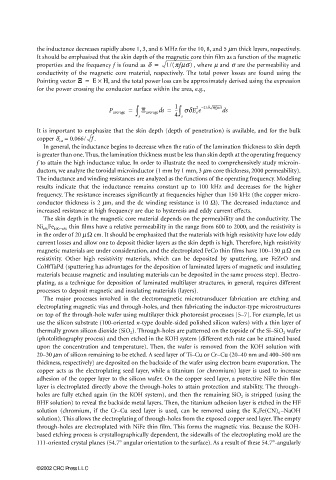Page 630 - The Mechatronics Handbook
P. 630
0066_Frame_C20.fm Page 100 Wednesday, January 9, 2002 1:44 PM
the inductance decreases rapidly above 1, 3, and 6 MHz for the 10, 8, and 5 µm thick layers, respectively.
It should be emphasized that the skin depth of the magnetic core thin film as a function of the magnetic
properties and the frequency f is found as d = 1/(pfms) , where µ and σ are the permeability and
conductivity of the magnetic core material, respectively. The total power losses are found using the
Pointing vector ΞΞ ΞΞ = E × H , and the total power loss can be approximately derived using the expression
for the power crossing the conductor surface within the area, e.g.,
P average = ∫ Ξ average s = 1 ∫ 2 – 2/dpfms s d
d
-- sdE o e
s 4 s
It is important to emphasize that the skin depth (depth of penetration) is available, and for the bulk
copper δ cu = 0.066/ f .
In general, the inductance begins to decrease when the ratio of the lamination thickness to skin depth
is greater than one. Thus, the lamination thickness must be less than skin depth at the operating frequency
f to attain the high inductance value. In order to illustrate the need to comprehensively study microin-
ductors, we analyze the toroidal microinductor (1 mm by 1 mm, 3 µm core thickness, 2000 permeability).
The inductance and winding resistances are analyzed as the functions of the operating frequency. Modeling
results indicate that the inductance remains constant up to 100 kHz and decreases for the higher
frequency. The resistance increases significantly at frequencies higher than 150 kHz (the copper micro-
conductor thickness is 2 µm, and the dc winding resistance is 10 Ω). The decreased inductance and
increased resistance at high frequency are due to hysteresis and eddy current effects.
The skin depth in the magnetic core material depends on the permeability and the conductivity. The
Ni x% Fe 100−x% thin films have a relative permeability in the range from 600 to 2000, and the resistivity is
in the order of 20 µ Ω cm. It should be emphasized that the materials with high resistivity have low eddy
current losses and allow one to deposit thicker layers as the skin depth is high. Therefore, high resistivity
magnetic materials are under consideration, and the electroplated FeCo thin films have 100–130 m Ω cm
resistivity. Other high resistivity materials, which can be deposited by sputtering, are FeZrO and
CoHfTaPd (sputtering has advantages for the deposition of laminated layers of magnetic and insulating
materials because magnetic and insulating materials can be deposited in the same process step). Electro-
plating, as a technique for deposition of laminated multilayer structures, in general, requires different
processes to deposit magnetic and insulating materials (layers).
The major processes involved in the electromagnetic microtransducer fabrication are etching and
electroplating magnetic vias and through-holes, and then fabricating the inductor-type microstructures
on top of the through-hole wafer using multilayer thick photoresist processes [5–7]. For example, let us
use the silicon substrate (100-oriented n-type double-sided polished silicon wafers) with a thin layer of
thermally grown silicon dioxide (SiO 2 ). Through-holes are patterned on the topside of the Si–SiO 2 wafer
(photolithography process) and then etched in the KOH system (different etch rate can be attained based
upon the concentration and temperature). Then, the wafer is removed from the KOH solution with
20–30 µm of silicon remaining to be etched. A seed layer of Ti–Cu or Cr–Cu (20–40 nm and 400–500 nm
thickness, respectively) are deposited on the backside of the wafer using electron beam evaporation. The
copper acts as the electroplating seed layer, while a titanium (or chromium) layer is used to increase
adhesion of the copper layer to the silicon wafer. On the copper seed layer, a protective NiFe thin film
layer is electroplated directly above the through-holes to attain protection and stability. The through-
holes are fully etched again (in the KOH system), and then the remaining SiO 2 is stripped (using the
BHF solution) to reveal the backside metal layers. Then, the titanium adhesion layer is etched in the HF
solution (chromium, if the Cr–Cu seed layer is used, can be removed using the K 3 Fe(CN) 6 –NaOH
solution). This allows the electroplating of through-holes from the exposed copper seed layer. The empty
through-holes are electroplated with NiFe thin film. This forms the magnetic vias. Because the KOH-
based etching process is crystallographically dependent, the sidewalls of the electroplating mold are the
111-oriented crystal planes (54.7° angular orientation to the surface). As a result of these 54.7°-angularly
©2002 CRC Press LLC

